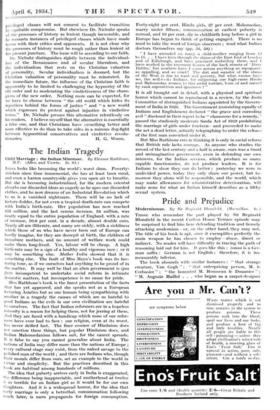The Indian Tragedy
Child Marriage : the Indian Minotaur. By Eleanor Rathbone, M.P. (Allen and Unwin. 2s. 6d.) INDIA looks like becoming the world's worst slum. Poverty- stricken since time immemorial, she has at least been rural, and even a barren countryside gives you open air to breathe. But she is becoming industrialized, for the modern oriental absorbs our discarded ideas as eagerly as he apes our discarded clothes, and he now dreams of an Industrial Revolution which to us is a vanished nightmare. There will be no lack of factory-fodder, for not even a tropical death-rate can compete with India's birth-rate. Her population has now reached 353 million, and the last census increase, 34 million, was nearly equal to the entire population of England, with a rate of increase, 10.6 per cent. in a decade, almost double ours. Nearly all are illiterate, and many are sickly, with a sickliness libich those of us who have never been out • of Europe can hardly imagine, for they are decrepit at birth, the children of immature mothers, and no amount of welfare work could make them long-lived. Yes, labour will be cheap. A high birth-rate may be a sign of a healthy and vigorous race ; or it may be something else. Mother India showed that it is something else. The fault of Miss Mayo's book was its hec- toring tone, as if we ourselves had anything to be proud of in the matter. It may well be that an alien government is ipso facto incompetent to undertake social reform in intimate domestic matters, but incompetence is no cause for pride.
Miss Rathbone's book is the finest presentation of the facts that has yet appeared, and she speaks not as a European lecturing Asiatics but as one human being sympathizing with another in a tragedy the causes of which are as hateful to good Indians as the evils in our own civilization are hateful to ourselves. The fact that Indian reformers are in a hopeless minority is a reason for helping them, not for jeering at them. And they are faced with a handicap which none of our refor- mers have ever had to face : our religion, even at its worst, has never deified lust. The finer essence of Hinduism does not sanction these things, but popular Hinduism does, and Indian Mahomedanism follows suit, for the cancer spreads. It is false to say you cannot generalize about India. The nations of India may differ more than the nations of Europe ; every cultural stage may exist, from the naked savage to the polished man of the world ; and there are Indians who, though their morals differ from ours, set an example to the world in virtue and simplicity. But the practices described in this book are habitual among hundreds of millions.
The idea that puberty arrives early in India is exaggerated, the difference being inappreciable, and motherhood at twelve
as terrible for an Indian girl as it would be for our own daughters. And it is a widespread horror, for the idea that early marriage is only a betrothal, consummation following much laterf is mere propaganda for foreign consumption.
Forty-eight per cent. Hindu girls, 37 per cent. Mahomedan, marry under fifteen ; consummation at earliest puberty, is normal, and 10 per cent. die in childbirth long before a girl in Europe has begun to think of getting engaged. There is no need to take the word of foreign observers ; read what Indian doctors, themselves say (pp. 36, 38) :
" I have attended on many a child-mother ranging from 12 'to 15. . . I have been through the slums of the East End of London . and of Edinburgh, and have practised midwifery there, and I have worked in the tenement houses of the back streets of ' Dirty Dublin,' but nowhere have I come across anything so repugnant, so appalling, and so cruel ! The dirt and squalor of, the slums of the West is due to want and poverty, but what excuse have we, the well-to-do Indians, for subjecting our high-caste Hindu and Mahomedan women to this awful torture, born of and nursed by rank superstition and ignorance 1"
It is all brought out in detail, with a physical and spiritual horror which cannot be reproduced in a review, by the Joshi Committee of distinguished Indians appointed by the Govern- ment of India in 1928. The Government (consisting equally of Indians and Englishmen) declared " the grave and corroding evil " disclosed in their report to be " clamorous for a remedy," passed the studiously moderate Sarda Act of 1929 prohibiting the marriage of girls under fourteen—and proceeded to make the act a dead letter, actually telegraphing to order the release of the first man convicted under it.
But Miss Rathbone errs in thinking it is only in social reform that British rule lacks courage. As anyone who studies the record of the last century and a half is aware, ours was a timid and unimaginative government, even in defending our own interests, for the Indian services, which produce so many capable functionaries, do not produce leaders. It is for Indians to show, they can do better ; yesterday we were in undivided power, today they only share our power, but to- morrow they alone will be responsible, and the world, which may make allowances for administrative deterioration, will make none for what an Indian himself describes as a filthy sexual system.








































 Previous page
Previous page